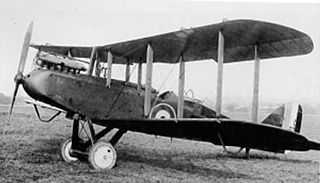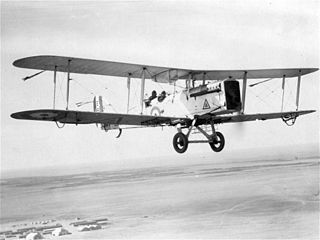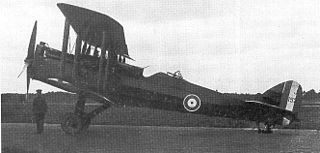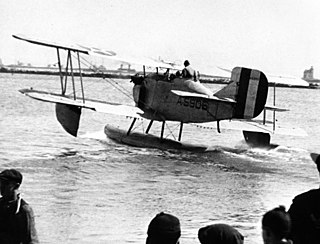The Aircraft Manufacturing Company Limited (Airco) was an early British aircraft manufacturer. Established during 1912, it grew rapidly during the First World War, referring to itself as the largest aircraft company in the world by 1918.

The de Havilland DH.87 Hornet Moth is a single-engined cabin biplane designed by the de Havilland Aircraft Company in 1934 as a potential replacement for its highly successful de Havilland Tiger Moth trainer. Although its side-by-side two-seat cabin made it closer in configuration to the modern aircraft that military trainee pilots would later fly, there was no interest from the RAF and the aircraft was put into production for private buyers.

The Douglas DT bomber was the Douglas Aircraft Company's first military contract, forging a link between the company and the United States Navy. Navy Contract No. 53305 of April 1, 1921, required only 18 pages to set out the specifications that resulted in the purchase of three DT folding-wing aircraft.

The Airco DH.4 is a British two-seat biplane day bomber of the First World War. It was designed by Geoffrey de Havilland for Airco, and was the first British two-seat light day-bomber capable of defending itself.

The de Havilland DH.85 Leopard Moth is a three-seat high-wing cabin monoplane designed and built by the de Havilland Aircraft Company in 1933.

The Airco DH.9 – also known after 1920 as the de Havilland DH.9 – is a British single-engined biplane bomber that was developed and deployed during the First World War.

The Airco DH.9A is a British single-engined light bomber that was designed and first used shortly before the end of the First World War. It was a development of the unsuccessful Airco DH.9 bomber, featuring a strengthened structure and, crucially, replacing the under-powered and unreliable inline 6-cylinder Siddeley Puma engine of the DH.9 with the American V-12 Liberty engine.

The de Havilland DH.93 Don was a 1930s British multi-role three-seat training aircraft built by de Havilland Aircraft.

The de Havilland DH.50 was a 1920s British large single-engined biplane transport built by de Havilland at Stag Lane Aerodrome, Edgware, and licence-built in Australia, Belgium, and Czechoslovakia.

The de Havilland DH.14 Okapi was a British two-seat day bomber of the 1910s built by de Havilland. The aircraft was designed as an Airco DH.4 and DH.9 replacement, but it never entered production.

The Airco DH.16 was an early British airliner designed by Geoffrey de Havilland, the chief designer at Airco. It accommodated a pilot plus four passengers, and was operated from 1919 to 1923.

The de Havilland DH.29 Doncaster was a British long-range high-wing monoplane of the 1920s built by de Havilland.

The BAT F.K.26 was a British single-engined four-passenger biplane transport aircraft produced by British Aerial Transport Company Limited of London at the end of World War I.

The de Havilland DH.18 was a single-engined British biplane transport aircraft of the 1920s built by de Havilland.

The de Havilland DH.34 was a single engined British biplane airliner built by the de Havilland Aircraft Company in the 1920s. 12 were built, with the DH.34 serving with Imperial Airways and its predecessors for several years.

The Dayton-Wright XPS-1 was an American single-seat fighter interceptor aircraft built by the Dayton-Wright Airplane Company.

The Dayton-Wright OW.1 Aerial Coupe was an American four-seat touring aircraft built by the Dayton-Wright Company of Dayton, Ohio. Because it was the last aircraft designed by Orville Wright, the design was given the designation OW.1. The aircraft was based on a heavily modified De Havilland DH.4. Although only one was produced, the Dayton-Wright OW.1 marks the first working example of a civilian single-engine four passenger light cabin aircraft in the US. The interior was designed for greater comfort compared to contemporaries, and was meant to be more like an automobile interior. It had a side-opening door with two rows of two seats, and a greater focus on luxury.

The Sopwith Wallaby was a British single-engined long-range biplane built during 1919 by Sopwith Aviation Company at Kingston upon Thames.

The Gloster A.S.31 Survey was a 1920s British photo-survey biplane developed by the Gloster Aircraft Company from the de Havilland DH.67 design project.

G Elias & Brother was an American manufacturer of cabinets and aircraft based in Buffalo, New York in the 1920s. A.G. Elias sat on the Manufacturers Aircraft Association's board of directors along with President Frank H. Russell, VP Glenn L. Martin, Charles L. Laurence, Chance M. Vought, S.S. Bradley, George P. Tidmarsh, and Donald Douglas. E.J Elias promoted the construction of a Buffalo municipal airport to aid the local fledgling airplane industry of five aviation companies constructing airplanes and airplane parts. From 1920 to 1925, Elias company's chief engineer, David Earle Dunlap (1896-1957), designed the Elias EM-2 Expeditionary planes. He designed the NBS-3 bomber fuselage and the Elias M-1 Mail plane. Dunlap's Elias TA-1 design was the first United States Army Air Corps Trainer to have a radial engine. After tests a McCook Field, the Army Air Corps selected other manufacturers over the Elias bomber and trainer. The company designed the Elias EM-1 to meet requirements for a multirole amphibian marine expeditionary aircraft. Elias delivered six production Elias EM-2 aircraft with Liberty engines to the United States Navy in 1922.



















